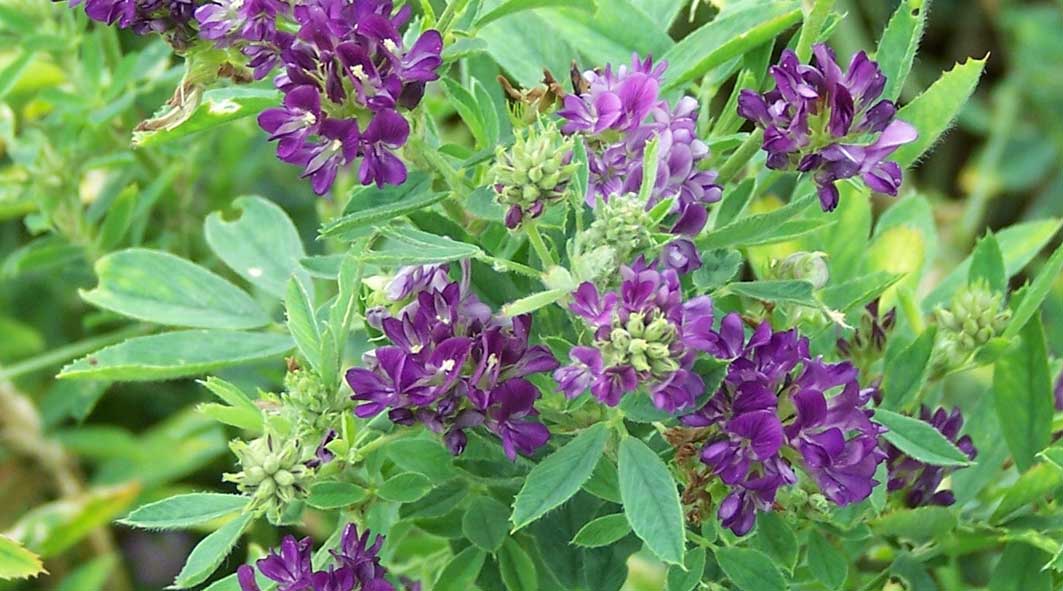Alfalfa, also known as lucerne, is an important forage crop grown around the world. This nutritious plant has been cultivated since ancient times to feed livestock. Today, there are many different varieties of alfalfa specially bred for certain climates and growing conditions. So what are the different types of alfalfa plants?
A Little About Alfalfa
Alfalfa is a perennial plant in the pea family that grows to about 1 meter tall. It has a deep taproot system that allows it to recover quickly after cutting or grazing. The leaves of alfalfa are trifoliate, meaning each leaf has three leaflets. Clusters of purple flowers bloom on alfalfa plants, which develop into coiled seed pods.
Alfalfa is highly nutritious livestock feed due to its high protein content. It also has the ability to fix nitrogen in the soil through a symbiotic relationship with rhizobium bacteria in its root nodules This improves soil fertility while providing high-quality forage Alfalfa is commonly harvested 3-4 times per year as hay, haylage, or grazed directly.
Key Types of Alfalfa
There are two main categories of alfalfa varieties – dormant and nondormant. Dormant varieties go dormant and stop growing in cold weather, while nondormant varieties continue growing through winter. Here are some of the most common alfalfa types:
Dormant Alfalfas
-
Vernal – An older, widely adapted variety good for surviving cold winters. Low disease resistance.
-
Ranger/Phytor – Improved winter hardiness and disease resistance Good yields
-
WL 354HQ – High forage quality and tonnage potential. Resists diseases.
-
Bulldog 805 – Highly winterhardy and productive. Good for Northern plains.
-
Fortress – Extreme winter hardiness for frigid climates like Canada.
Nondormant Alfalfas
-
SW9720 – High yielding variety for Southwest US. Heat and drought tolerant.
-
SW10 – Improved nondormant for West Coast. High forage quality.
-
Aqua-28R – High yield potential and forage quality for arid Western US.
-
HybriForce-3400 – Very high yield and forage quality. For Southern plains.
-
Alfagraze 600RR – Roundup Ready variety for Southern US.
Other Types
-
CUF 101 – Branching root traits improve phosphorus uptake on low fertility soils.
-
HarvXtra – Reduced lignin for faster drying as hay.
-
Roundup Ready – Genetically modified for glyphosate herbicide tolerance.
-
Salt Tolerant – Improved salt tolerance for irrigation with salty water.
-
Multileaf – More than 3 leaflets per leaf for higher quality.
Choosing the Right Alfalfa
It’s important to select an alfalfa variety matched to your specific conditions. Factors like winter hardiness, disease resistance, and drought tolerance should be considered. Your local extension service can provide variety trial data for your region. It’s also a good idea to plant more than one variety to spread risk. With so many types available, every grower can find just the right alfalfa plants for their needs.

Manage for Top Performance
Increase your production and maximize quality with improved production practices. Get the latest agronomic resources and information straight from our experts in the field.
11AFT with Nutrivail® Feed Technology
Pioneer® inoculant 11AFT is a revolutionary patented alfalfa silage product featuring our Nutrivail® feed technology. 11AFT offers improved fiber digestibility, higher forage energy density and better alfalfa fermentation.
Pioneer® inoculant 11G22 with Rapid React® technology and next-generation Lactobacillus buchneri strains enhances fermentation to minimize aerobic dry matter losses for improved silage quality.
Pioneer® inoculant 11H50 is an alfalfa silage inoculant designed to speed up fermentation, reduce protein degradation and improve dry matter recovery.
Pioneer® inoculant 1174 helps improve fermentation and retain nutrient content.
Ask the Alfalfa Expert – Alfalfa Varieties
FAQ
How many types of alfalfa are there?
What are the names of alfalfa?
Why is alfalfa not grown in the south?
What is the best crop to plant with alfalfa?
